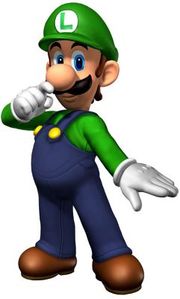Luigi: Difference between revisions
| Line 50: | Line 50: | ||
Luigi is once again an unlockable character and can be unlocked by playing twenty-two vs matches, completing [[Classic Mode]], or by getting Luigi to join your party in [[The Subspace Emissary]]. Luigi also features his own unique voice acting, rather than just Mario's voice clips sped up. The main difference between Luigi now and his previous Melee appearance is his Final Smash, the unorthodox [[Negative Zone]]. | Luigi is once again an unlockable character and can be unlocked by playing twenty-two vs matches, completing [[Classic Mode]], or by getting Luigi to join your party in [[The Subspace Emissary]]. Luigi also features his own unique voice acting, rather than just Mario's voice clips sped up. The main difference between Luigi now and his previous Melee appearance is his Final Smash, the unorthodox [[Negative Zone]]. | ||
[[Category:Characters]] | [[Category:Characters]] | ||
[[Category:Stickers]] | [[Category:Stickers]] | ||
[[Category:Mario universe]] | [[Category:Mario universe]] | ||
Revision as of 11:25, April 2, 2009
- For fighter info, see Luigi (SSB), Luigi (SSBM), and Luigi (SSBB).
| Luigi | |
|---|---|
 Official artwork of Luigi. | |
| Universe | Mario |
| Debut | Mario Bros. (1983) |
| Smash Bros. appearances | SSB Melee Brawl SSB4 Ultimate |
| Console/platform of origin | Arcade |
| Species | Human |
| Gender | Male |
| Place of origin | Mushroom Kingdom |
| Created by | Shigeru Miyamoto |
| Voice actor | Video games Mark Graue (1994) Charles Martinet (1996-present) Cartoons Danny Wells (The Super Mario Bros. Super Show) Tony Rosato (Super Mario Bros. 3 and Super Mario World) |
| Japanese voice actor | Yuu Mizushima (Super Mario Bros.: The Great Mission to Rescue Princess Peach) Naoki Tatsuta (OVA Trilogy) |
Luigi (ルイージ) is a character in the Mario series. He is the younger brother of the more-famous Mario, but is still a prominent character (and second only to his older brother) in the series of the same name. He has featured as a playable character in Super Smash Bros., Super Smash Bros. Melee and Super Smash Bros. Brawl.
Interestingly, Luigi is only one of two characters (alongside Jigglypuff) to appear in all three Smash Bros. games as an unlockable character. The criteria to unlock him often has a relation to the number 2, in reference to his status relative to Mario.
Character description
Two years after his brother, Mario, made his first appearance in the Arcade classic "Donkey Kong," Luigi would make his first appearance in Mario Bros. for the arcade as the character the second player would control. His appearance is a palette swap of Mario, except colored with green instead of red. He was named after a pizza parlor which was near Nintendo of America's headquarters called "Mario & Luigi's".
Luigi would then once again be featured in the world-famous Super Mario Bros. for the NES, which saw the two brothers traveling through the Mushroom Kingdom for the first to rescue Princess Peach (then called "Princess Toadstool") from the evil Koopa King, Bowser. Here Luigi was clad in white overalls and hat compared to his usual green color scheme. In Super Mario Bros. 2 (both the U.S. and Japanese versions) he would be established as actually having a superior jumping ability to Mario, but having worse traction. However, the U.S. Version did establish that Luigi was both taller and thinner than his older brother. In "Super Mario Bros. 3" , Luigi once again looked no different than Mario.
Over the years, while Mario appeared in more and more games, Luigi started taking a backseat to his older brother, even being left out of some games entirely. While he appeared as the solo playable character in Mario is Missing, this was not a "true" Mario title. The most notable of these was Luigi's complete absence in the world-famous Super Mario 64 which garnered some controversy.
However, he would soon make his first appearance in a fighting game in Super Smash Bros. and following that, garnered the spotlight in his own game Luigi's Mansion which launched the GameCube. Since then, Nintendo has made a more conscious effort to include Luigi in more games, playable or otherwise, he starred alongside Mario in the Mario and Luigi games for the Game Boy Advance and Nintendo DS and was a playable character in Super Paper Mario (after appearing as a non-playable character in the first two Paper Mario games). He has even been made into a playable character in Super Mario Galaxy after the game is beaten as Mario. Things have since been looking up for Luigi, and while he is less famous than Mario, he is a popular character among gamers.
In Super Smash Bros.
In Super Smash Bros. Melee
In Super Smash Bros. Brawl
- Main article: Luigi (SSBB)
Luigi is once again an unlockable character and can be unlocked by playing twenty-two vs matches, completing Classic Mode, or by getting Luigi to join your party in The Subspace Emissary. Luigi also features his own unique voice acting, rather than just Mario's voice clips sped up. The main difference between Luigi now and his previous Melee appearance is his Final Smash, the unorthodox Negative Zone.
